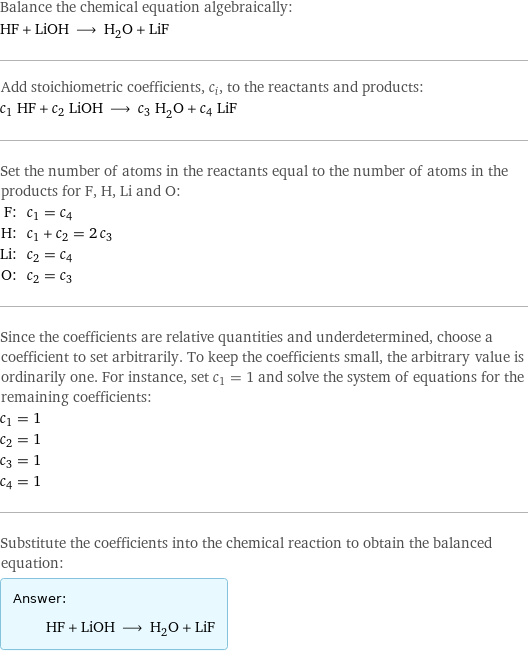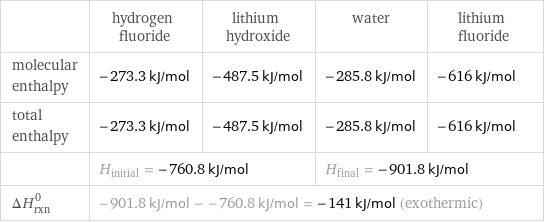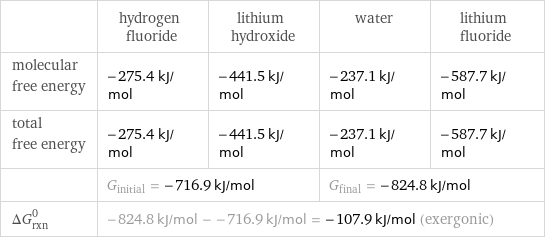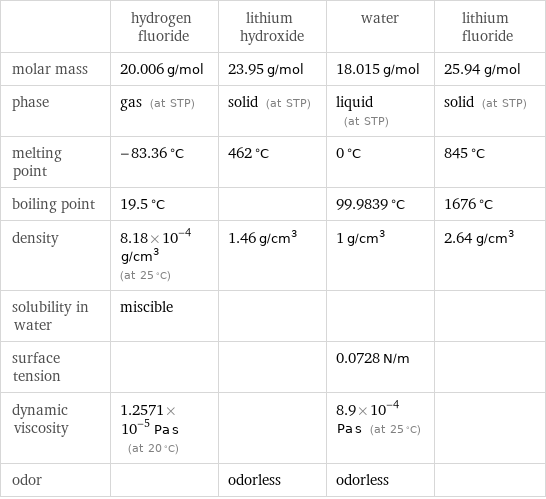Input interpretation

HF hydrogen fluoride + LiOH lithium hydroxide ⟶ H_2O water + LiF lithium fluoride
Balanced equation

Balance the chemical equation algebraically: HF + LiOH ⟶ H_2O + LiF Add stoichiometric coefficients, c_i, to the reactants and products: c_1 HF + c_2 LiOH ⟶ c_3 H_2O + c_4 LiF Set the number of atoms in the reactants equal to the number of atoms in the products for F, H, Li and O: F: | c_1 = c_4 H: | c_1 + c_2 = 2 c_3 Li: | c_2 = c_4 O: | c_2 = c_3 Since the coefficients are relative quantities and underdetermined, choose a coefficient to set arbitrarily. To keep the coefficients small, the arbitrary value is ordinarily one. For instance, set c_1 = 1 and solve the system of equations for the remaining coefficients: c_1 = 1 c_2 = 1 c_3 = 1 c_4 = 1 Substitute the coefficients into the chemical reaction to obtain the balanced equation: Answer: | | HF + LiOH ⟶ H_2O + LiF
Structures

+ ⟶ +
Names

hydrogen fluoride + lithium hydroxide ⟶ water + lithium fluoride
Reaction thermodynamics
Enthalpy

| hydrogen fluoride | lithium hydroxide | water | lithium fluoride molecular enthalpy | -273.3 kJ/mol | -487.5 kJ/mol | -285.8 kJ/mol | -616 kJ/mol total enthalpy | -273.3 kJ/mol | -487.5 kJ/mol | -285.8 kJ/mol | -616 kJ/mol | H_initial = -760.8 kJ/mol | | H_final = -901.8 kJ/mol | ΔH_rxn^0 | -901.8 kJ/mol - -760.8 kJ/mol = -141 kJ/mol (exothermic) | | |
Gibbs free energy

| hydrogen fluoride | lithium hydroxide | water | lithium fluoride molecular free energy | -275.4 kJ/mol | -441.5 kJ/mol | -237.1 kJ/mol | -587.7 kJ/mol total free energy | -275.4 kJ/mol | -441.5 kJ/mol | -237.1 kJ/mol | -587.7 kJ/mol | G_initial = -716.9 kJ/mol | | G_final = -824.8 kJ/mol | ΔG_rxn^0 | -824.8 kJ/mol - -716.9 kJ/mol = -107.9 kJ/mol (exergonic) | | |
Equilibrium constant
![Construct the equilibrium constant, K, expression for: HF + LiOH ⟶ H_2O + LiF Plan: • Balance the chemical equation. • Determine the stoichiometric numbers. • Assemble the activity expression for each chemical species. • Use the activity expressions to build the equilibrium constant expression. Write the balanced chemical equation: HF + LiOH ⟶ H_2O + LiF Assign stoichiometric numbers, ν_i, using the stoichiometric coefficients, c_i, from the balanced chemical equation in the following manner: ν_i = -c_i for reactants and ν_i = c_i for products: chemical species | c_i | ν_i HF | 1 | -1 LiOH | 1 | -1 H_2O | 1 | 1 LiF | 1 | 1 Assemble the activity expressions accounting for the state of matter and ν_i: chemical species | c_i | ν_i | activity expression HF | 1 | -1 | ([HF])^(-1) LiOH | 1 | -1 | ([LiOH])^(-1) H_2O | 1 | 1 | [H2O] LiF | 1 | 1 | [LiF] The equilibrium constant symbol in the concentration basis is: K_c Mulitply the activity expressions to arrive at the K_c expression: Answer: | | K_c = ([HF])^(-1) ([LiOH])^(-1) [H2O] [LiF] = ([H2O] [LiF])/([HF] [LiOH])](../image_source/3b19482bc47f0f6740861f9a56560fa2.png)
Construct the equilibrium constant, K, expression for: HF + LiOH ⟶ H_2O + LiF Plan: • Balance the chemical equation. • Determine the stoichiometric numbers. • Assemble the activity expression for each chemical species. • Use the activity expressions to build the equilibrium constant expression. Write the balanced chemical equation: HF + LiOH ⟶ H_2O + LiF Assign stoichiometric numbers, ν_i, using the stoichiometric coefficients, c_i, from the balanced chemical equation in the following manner: ν_i = -c_i for reactants and ν_i = c_i for products: chemical species | c_i | ν_i HF | 1 | -1 LiOH | 1 | -1 H_2O | 1 | 1 LiF | 1 | 1 Assemble the activity expressions accounting for the state of matter and ν_i: chemical species | c_i | ν_i | activity expression HF | 1 | -1 | ([HF])^(-1) LiOH | 1 | -1 | ([LiOH])^(-1) H_2O | 1 | 1 | [H2O] LiF | 1 | 1 | [LiF] The equilibrium constant symbol in the concentration basis is: K_c Mulitply the activity expressions to arrive at the K_c expression: Answer: | | K_c = ([HF])^(-1) ([LiOH])^(-1) [H2O] [LiF] = ([H2O] [LiF])/([HF] [LiOH])
Rate of reaction
![Construct the rate of reaction expression for: HF + LiOH ⟶ H_2O + LiF Plan: • Balance the chemical equation. • Determine the stoichiometric numbers. • Assemble the rate term for each chemical species. • Write the rate of reaction expression. Write the balanced chemical equation: HF + LiOH ⟶ H_2O + LiF Assign stoichiometric numbers, ν_i, using the stoichiometric coefficients, c_i, from the balanced chemical equation in the following manner: ν_i = -c_i for reactants and ν_i = c_i for products: chemical species | c_i | ν_i HF | 1 | -1 LiOH | 1 | -1 H_2O | 1 | 1 LiF | 1 | 1 The rate term for each chemical species, B_i, is 1/ν_i(Δ[B_i])/(Δt) where [B_i] is the amount concentration and t is time: chemical species | c_i | ν_i | rate term HF | 1 | -1 | -(Δ[HF])/(Δt) LiOH | 1 | -1 | -(Δ[LiOH])/(Δt) H_2O | 1 | 1 | (Δ[H2O])/(Δt) LiF | 1 | 1 | (Δ[LiF])/(Δt) (for infinitesimal rate of change, replace Δ with d) Set the rate terms equal to each other to arrive at the rate expression: Answer: | | rate = -(Δ[HF])/(Δt) = -(Δ[LiOH])/(Δt) = (Δ[H2O])/(Δt) = (Δ[LiF])/(Δt) (assuming constant volume and no accumulation of intermediates or side products)](../image_source/b56a6184ab3ded6784d0b7e22daa48f0.png)
Construct the rate of reaction expression for: HF + LiOH ⟶ H_2O + LiF Plan: • Balance the chemical equation. • Determine the stoichiometric numbers. • Assemble the rate term for each chemical species. • Write the rate of reaction expression. Write the balanced chemical equation: HF + LiOH ⟶ H_2O + LiF Assign stoichiometric numbers, ν_i, using the stoichiometric coefficients, c_i, from the balanced chemical equation in the following manner: ν_i = -c_i for reactants and ν_i = c_i for products: chemical species | c_i | ν_i HF | 1 | -1 LiOH | 1 | -1 H_2O | 1 | 1 LiF | 1 | 1 The rate term for each chemical species, B_i, is 1/ν_i(Δ[B_i])/(Δt) where [B_i] is the amount concentration and t is time: chemical species | c_i | ν_i | rate term HF | 1 | -1 | -(Δ[HF])/(Δt) LiOH | 1 | -1 | -(Δ[LiOH])/(Δt) H_2O | 1 | 1 | (Δ[H2O])/(Δt) LiF | 1 | 1 | (Δ[LiF])/(Δt) (for infinitesimal rate of change, replace Δ with d) Set the rate terms equal to each other to arrive at the rate expression: Answer: | | rate = -(Δ[HF])/(Δt) = -(Δ[LiOH])/(Δt) = (Δ[H2O])/(Δt) = (Δ[LiF])/(Δt) (assuming constant volume and no accumulation of intermediates or side products)
Chemical names and formulas

| hydrogen fluoride | lithium hydroxide | water | lithium fluoride formula | HF | LiOH | H_2O | LiF Hill formula | FH | HLiO | H_2O | FLi name | hydrogen fluoride | lithium hydroxide | water | lithium fluoride
Substance properties

| hydrogen fluoride | lithium hydroxide | water | lithium fluoride molar mass | 20.006 g/mol | 23.95 g/mol | 18.015 g/mol | 25.94 g/mol phase | gas (at STP) | solid (at STP) | liquid (at STP) | solid (at STP) melting point | -83.36 °C | 462 °C | 0 °C | 845 °C boiling point | 19.5 °C | | 99.9839 °C | 1676 °C density | 8.18×10^-4 g/cm^3 (at 25 °C) | 1.46 g/cm^3 | 1 g/cm^3 | 2.64 g/cm^3 solubility in water | miscible | | | surface tension | | | 0.0728 N/m | dynamic viscosity | 1.2571×10^-5 Pa s (at 20 °C) | | 8.9×10^-4 Pa s (at 25 °C) | odor | | odorless | odorless |
Units
